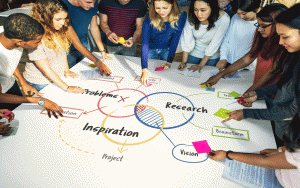Design Thinking – What is it and how can it support 21st century education?
There is no question about it. Teachers are getting more and more intrigued and excited about Design Thinking and how it can support the developments of necessary skills in students today.
So what is Design Thinking?
Developed by IDEO founder David Kelley, design thinking is defined as “a human-centred approach to innovation that draws from the designer’s toolkit to integrate the needs of people, the possibilities of technology and the requirements for business success.” Design Thinking uses the Stanford d.school and IDEO design methodology in a five step process, open across all industries and all cultures. It moves away from the concept of ‘design’ as being only aesthetics and style, instead applying it to a broader set of issues and problems in business and society.
Design thinking is a methodology which encourages creativity and innovation through rapid (and cheap) prototyping early in the design process. It encourages risk taking, accepts failure and depends on testing and feedback in order to reach the best final outcome. But perhaps the most important aspect of design thinking is its human-centric focus. The design thinking process focuses on reconnecting to a person or community and to truly understanding their fundamental needs.
It is no longer possible today to design new products or services without awareness and a responsible commitment to the current difficulties we face locally, nationally and internationally.
“We must strive to improve our understanding of innovation processes in order to bring better solutions to society more quickly.”Hasso Plattner, HPI School of Design Thinking.
The design thinking process as developed by Stanford d.school and IDEO design includes the following steps:
- Empathising: Understanding the human needs involved by observing, listening and questioning. Understanding culture and context.
- Defining: Re-framing and re-defining the problem in a meaningful and actionable way.
- Ideating: Creating many ideas in brainstorming sessions.
- Prototyping: Develop a cheap, small-scale version of the product, idea or service and adopting a rapid and hands-on approach to the process of prototyping. Taking risks and getting feedback in order to evolve the product and get the best final outcome.
- Testing: Testing the final prototype or solution to the problem.
What is the role for design thinking in 21st century education?
Modern society is demanding that students have the skills and the tools to participate actively to manage situations and problems which are increasingly complex. Design thinking takes students further than just finding ‘the right answer’ to problems. It’s a methodology for how to address complex problems to which they don’t know what the ‘right answer’ should look like.
The research project “Destination, Imagination, and the Fires Within: Design Thinking in a Middle School Classroom” identified the most important learning outcome as being “the ability to imagine without boundaries and constraints. This is critical, as the development of creative confidence is an essential part of learning. Design thinking may help students become empowered agents in their own learning who possess both the tools and the confidence to change the world.”
What can Design Thinking add to classroom learning?
“If we teach today’s students as we taught yesterday’s, we rob them of tomorrow.” John Dewey.
Moving towards further integration of this innovative process in classroom learning has the capacity to give students an edge in the future. It provides them with a ‘real-world’ subject to fully engage them when answering questions at university entrance, or job interviews. If started early, it can provide them with an extended skillset and empower them to take ownership of their own education. It can allow them to thrive in complex situations, bettering their own lives, and more importantly bettering the lives of others.
 Real World Design Challenge – 5 Day program
Real World Design Challenge – 5 Day program
Latitude Group Travel has developed a 5 day Real World Design Program which is an open-ended project that pushed students to imagine and create without boundaries and constraints. Students learn the 5 step Stanford d.school and IDEO Design Thinking methodology through finding a solution to a real-world problem they have identified in their communities.
Resources
- Klaus Schwab, Founder and Executive Chairman, World Economic Forum Geneva
- Destination, Imagination, and the Fires Within: Design Thinking in a Middle School Classroom.
https://web.stanford.edu/group/redlab/cgi-bin/materials/IJADE_Article.pdf
- Kwek, D. (2011). Innovation in the Classroom: Design Thinking for 21st Century Learning. Stanford University. Unpublished Master’s Thesis. https://web.stanford.edu/group/redlab/cgi-bin/materials/Kwek-Innovation%20In%20The%20Classroom.pdf


